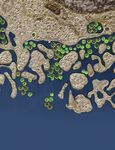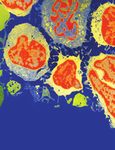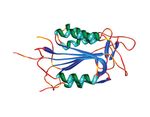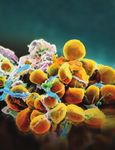Case Report Intestinal Myiasis Caused by Sarcophaga spp. in Cusco, Peru: A Case Report and Review of the Literature
←
→
Page content transcription
If your browser does not render page correctly, please read the page content below
Hindawi
Case Reports in Infectious Diseases
Volume 2018, Article ID 3685439, 4 pages
https://doi.org/10.1155/2018/3685439
Case Report
Intestinal Myiasis Caused by Sarcophaga spp. in Cusco, Peru:
A Case Report and Review of the Literature
Priscilla Ly,1 Adiel Aizenberg ,1 Taylor Martin ,1 Martha Lopez,2
Miguel Arturo Saldaña,3 Grant Leslie Hughes,4 and Miguel Mauricio Cabada 2,5
1
School of Medicine, University of Texas Medical Branch, 301 University Boulevard, Galveston, TX 77555, USA
2
Cusco Branch, Tropical Medicine Institute, Universidad Peruana Cayetano Heredia, Calle Jose Carlos Mariategui J-6, Wanchaq,
Cusco, Peru
3
Department of Microbiology and Immunology, University of Texas Medical Branch, 301 University Boulevard, Galveston,
TX 77555, USA
4
Department of Pathology, University of Texas Medical Branch, 301 University Boulevard, Galveston, TX 77555, USA
5
Division of Infectious Diseases, Department of Internal Medicine, University of Texas Medical Branch,
301 University Boulevard RT 0435, Galveston, TX 77555, USA
Correspondence should be addressed to Miguel Mauricio Cabada; micabada@utmb.edu
Received 12 March 2018; Accepted 6 May 2018; Published 27 May 2018
Academic Editor: Larry M. Bush
Copyright © 2018 Priscilla Ly et al. This is an open access article distributed under the Creative Commons Attribution License,
which permits unrestricted use, distribution, and reproduction in any medium, provided the original work is properly cited.
Myiasis is the infestation by dipterous fly larvae in humans and animals. The larvae can infect living or necrotic tissue involving the
skin, nasopharynx, genitourinary, and gastrointestinal tracts. The accidental ingestion of eggs causes infection of the intestinal tract.
We report a case of intestinal myiasis caused by Sarcophaga spp. larvae in a two-year-old child from Limatambo province in the
Cusco region of Peru. Live larvae were identified incidentally in this child’s stool sample during the study screening for Strongyloides
stercoralis. The child did not have any constitutional or abdominal symptoms. The morphological examination of the specimen under
magnification revealed Sarcophaga spp. larvae. We performed a literature review of publications reporting intestinal myiasis caused
by Sarcophaga spp. and discussed key aspects of this infestation.
1. Introduction are considered facultative or accidental myiasis [5]. Fly
larvae that can cause a parasitic infestation but can also
Myiasis is the infestation with dipterous fly larvae of complete their cycle in the environment are considered
humans and other mammals, typically livestock [1]. facultative. Although these commonly cause wound or
Myiasis is a natural infection of livestock causing a sig- necrotic tissue myiasis, eggs or larvae in the environment
nificant burden on this industry. Occasionally, humans can be accidentally ingested causing intestinal myiasis [6].
exposed to endemic areas suffer from zoonotic fly larvae The diagnosis is confirmed when the offending larvae are
infestations [2]. The fly larvae feed on living or necrotic passed in one or more consecutive stool samples [7]. Intestinal
host tissue, bodily fluids, or ingested food [3]. Human myiasis is generally transient and asymptomatic, though
myiasis affects the skin most often and also can affect other symptoms may include nausea, vomiting, and abdominal
organs, such as the nasopharynx, digestive tract, ear canal, pain [8, 9]. Intestinal myiasis caused by the larvae of the
orbits, and genitourinary tract [4]. Several classifications of flesh fly Sarcophaga spp. is reported in several countries,
myiasis have been proposed mostly depending on the but to date no case has been reported in Peru. We report
anatomical location of the infestation, the stage of the larval a case of intestinal myiasis caused by Sarcophaga spp. in the
development, or the existence of an obliged parasitic stage highlands of Peru and present a review of the literature
[1]. Most of the fly species that cause intestinal infestation about intestinal myiasis.2 Case Reports in Infectious Diseases
(a) (b) (c)
Figure 1: (a) Anterior end of the Sarcophaga spp: larva with two oral hooks. (b) Posterior spiracles located deep inside a fossa with
surrounding tubercles. (c) Three parallel slits surrounded by an incomplete peritreme.
2. Case Presentation 3. Discussion
A two-year-old male from Sauceda, a rural community of Several species of dipterous larvae including Sarcophaga spp.
Limatambo district (elevation 2,550 meters) in the Cusco are capable of producing intestinal myiasis [8]. In most cases,
region of Peru, presented with four white, mobile larvae in his the infection is caused by accidental ingestion of eggs laid on
stool measuring approximately 12 mm. This child was a par- exposed food [12]. As contaminated food passes through the
ticipant in a community study evaluating the prevalence of alimentary tract, eggs will hatch, and released larvae inhabit
Strongyloides stercoralis infection. Participants in this study the lower gastrointestinal tract before being passed in the stool
were instructed to collect freshly produced stool samples di- [12]. Sarcophaga larvae, the genus of the flesh fly family, are
rectly in clean plastic containers and to close them with equipped to feed from tissue and can cause damage to the
a hermetic lid. The stool samples were immediately tested by intestinal mucosa accounting for the symptoms reported in
the agar plate culture method. This method uses a Petri dish some patients [13]. The infestation is self-limited in most cases
with a nutritive agar in which a portion of the stool sample is because larvae are excreted in the stool, where they are often
placed. Then a lid is taped hermetically to prevent Strong- found alive. This infestation does not allow for reproduction
yloides larvae from escaping, and the dish is incubated to of larvae inside the host; however, with repeated ingestion of
observe the track left by Strongyloides larvae in the agar. The fly eggs, protracted cases have been reported with patients passing
larvae were discovered incidentally in the agar culture plate of larvae for months or years [14]. Intestinal myiasis should be
this child. The patient was previously healthy, and the mother differentiated from pseudomyiasis, in which the patients ingest
denied any symptoms including fever, nausea, vomiting, di- larvae rather than eggs and then pass intact larvae in the stool
arrhea, and abdominal pain. He did not have any apparent [15]. The larvae in pseudomyiasis are passed dead and never
skin wounds on his body. The mother reported that the child’s truly colonize the intestinal tract [15]. Larva can also be
diet consisted of poultry, fruit, and vegetables. He lived with deposited in fecal samples left uncovered and typically present
several extended family members in an adobe house with dirt at earlier stages of development upon examination.
floors and opened windows. Several animals including dogs, Our patient presented with multiple, living, L3 larvae in
cats, ducks, and chickens roamed freely in and out of the his stools and thus likely contracted intestinal myiasis from
household. The house was largely infested with flies. accidental ingestion of eggs. He lived in an adobe house from
Morphological examination of the organism revealed a rural community in close contact with several animals.
features consistent with L3 larvae of Sarcophaga spp. The Poor hygienic practices, lack of refrigeration of food, the
larva had smooth body segments with a broad posterior end proximity to a variety of farm animals, and open dwelling
and a tapering anterior end with two oral hooks and mouth allowed for potential sources of infection in our patient [16].
brushes (Figure 1(a)). The posterior spiracles were located In rural areas, domestic animals like dogs and cats are
deep inside a fossa, surrounded by more than 10 tubercles sometimes infested with fly larvae and can be a source for
(Figure 1(b)). The hidden spiracles had the characteristic infection in children [17]. There have been reports of in-
findings of the genus Sarcophaga. The posterior spiracles testinal myiasis caused by ingestion of over ripened fruits
consisted of three parallel slits surrounded by an incomplete such as pears or bananas [18, 19]. Drinking contaminated
peritreme, with the inner slit directed away from the median water has also been reported as a source of infection [20].
line ventrally (Figure 1(c)). These findings are supported by Several cases of intestinal myiasis caused by Sar-
the diagnostic criteria of Sarcophaga spp. reported in the cophaga spp. have been reported in the literature (Table 1).
literature [10, 11]. The four species identified include Sarcophaga crassipalpis,Case Reports in Infectious Diseases 3
Table 1: Human cases of intestinal myiasis caused by Sarcophaga spp. reported in the literature.
Author/year Species Age Sex Country Exposure Symptoms
Shiota et al. Sarcophaga Contaminated Abdominal pain, fever, vomiting, and
4 Male Japan
1990 [13] crassipalpis food diarrhea
Sarcophaga Contaminated
2 Female Japan Abdominal pain
Nagakura et al. crassipalpis food
1991 [18] Sarcophaga Contaminated
38 Male Japan Asymptomatic
peregrina food
Tachibana et al. Sarcophaga Contaminated
Unknown Unknown Japan Asymptomatic
1987 [21] peregrina food
Hasegawa et al. Sarcophaga
8 months Female Japan Unknown Change in behavior and bloody stools
1992 [22] peregrina
Sarcophaga Abdominal pain, diarrhea, and
25 Male India Unknown
haemorrhoidalis flatulence
Sarcophaga
35 Male India Unknown Abdominal pain and flatulence
haemorrhoidalis
Udgaonkar et al. Sarcophaga
28 Male India Unknown Abdominal pain and flatulence
2012 [14] haemorrhoidalis
Sarcophaga Living in a rural Abdominal pain, flatulence, and
30 Male India
haemorrhoidalis area generalized weakness
Sarcophaga Living in a rural
38 Male India Abdominal pain and flatulence
haemorrhoidalis area
Sarcophaga United Flatulence, generalized weakness, loss
37 Female Unknown
bullata States of appetite, and weight loss
Sarcophaga United Generalized weakness, loss of appetite,
66 Female Unknown
bullata States and weight loss
Watson 1942 [23]
Sarcophaga United Abdominal pain, flatulence, and
43 Male Unknown
bullata States generalized weakness
Sarcophaga United Abdominal pain, flatulence,
51 Male Unknown
bullata States constipation, and loss of appetite
Kenney et al. United
Sarcophaga spp. 60 Male Unknown Unknown
1976 [24] States
Abdominal pain, loss of appetite,
Ahmad et al. Living in a rural
Sarcophaga spp. 10 Male Egypt nausea, vomiting, diarrhea, and bloody
2011 [25] area
stools
Das et al. 2010 [8] Sarcophaga spp. 25 Male India Unknown Asymptomatic
Watanabe et al. Contaminated
Sarcophaga spp. 61 Male Japan Diarrhea
2016 [4] food
Sarcophaga peregrina, Sarcophaga haemorrhoidalis, and eliminate intestinal larvae almost immediately [14]. Treatment
Sarcophaga bullata. The age of patients reported varies with antihelminthic medications such as albendazole has not
widely from 8 months to 66 years, being the average 33 shown to improve symptoms in patients [8, 9, 14]. Education
years at presentation. The flesh fly belonging to the Sar- on good food-handling practices and avoiding the con-
cophagidae family has worldwide distribution [8]. Cases sumption of food products exposed to flies is important for
have been reported from Japan, India, Egypt, and the prevention of this disease [14]. No reports of oral ivermectin
United States. The signs and symptoms of presentation are use have been published in intestinal myiasis, but this might
nonspecific and vary between reports, with some patients be a therapeutic option in severe cases.
being asymptomatic like in this child’s case [13]. Sarcophaga In conclusion, intestinal myiasis caused by Sarcophaga spp.
species are generally present in rural and urban environments is a rare occurrence in humans that is often self-limited. Pa-
and are commonly found in houses and indoor dwellings [25]. tients may have a range of presentations going from asymp-
Our review revealed that living in rural areas and the ingestion tomatic to nonspecific abdominal symptoms. Intestinal myiasis
of contaminated food products were factors that authors as- can pose a diagnostic challenge for physicians unfamiliar with
sociated with infestation by Sarcophaga spp. the condition. Education on good food handling is advised to
Intestinal myiasis can be largely benign or cause severe prevent reinfection.
clinical symptoms, depending on the larval species, number,
and location within the digestive tract [14, 26]. In some cases, Data Availability
like ours, larvae can be passed out in feces without causing
many symptoms [14]. Colonic washes with polyethylene glycol Data will be freely available through the corresponding
have been reported to relieve gastrointestinal symptoms and author upon request.4 Case Reports in Infectious Diseases
Conflicts of Interest [19] D. E. North, K. L. Matteson, S. D. Helgerson et al., “Intestinal
myiasis in a baby attending a public health clinic,” Nurse
The authors declare that they have no conflicts of interest. Practitioner, vol. 12, no. 5, pp. 60–62, 1987.
[20] A. Clavel, M. Toledo, P. Goni, and C. Aspiroz, “Intestinal
myiasis due to Eristalis tenax: report of a new case in Spain,”
References New Microbiologia, vol. 34, pp. 335-336, 2011.
[21] H. Tachibana, M. Sasao, T. Tanaka et al., “A case of intestinal
[1] F. Francesconi and O. Lupi, “Myiasis,” Clinical Microbiology myiasis in Japan,” Tokai Journal of Experimental and Clinical
Reviews, vol. 25, pp. 79–105, 2012. Medicine, vol. 12, no. 5–6, pp. 349–352, 1988.
[2] D. John and W. Petri, Markell and Voge’s Medical Parasitology, [22] S. Hasegawa, H. Miwata, S. Masuda, H. Naruse, and T. Ozaki,
Saunders Elsevier, Missouri, USA, 9th edition, 2006. “An infantile case of intestinal myiasis,” Pediatrics In-
[3] R. Sehgal, H. P. S. Bhatti, D. K. Bhasin et al., “Intestinal ternational, vol. 34, no. 1, pp. 87–89, 1992.
myiasis due to Musca domestica: a report of two cases,” Japan [23] J. R. Watson, “Sarcophaga bullata parker as a cause of in-
Journal of Infectious Disease, vol. 55, pp. 191–193, 2002. testinal myiasis,” Florida Entomologist, vol. 25, no. 1, pp. 5-6,
[4] N. Watanabe, T. Kato, Y. Ichiyanagi et al., “A case report of 1942.
intestinal myiasis in a Japanese man,” Open Journal of Pa- [24] M. Kenney, L. K. Eveland, V. Yermakov, and D. Y. Kassouny,
thology, vol. 6, no. 4, pp. 171–176, 2016. “Two cases of enteric myiasis in man: pseudomyiasis and true
[5] M. T. Shazia, S. Anjum, and M. J. Yousuf, “Systematics and intestinal myiasis,” American Journal of Clinical Pathology,
population of sarcophagid flies in Faisalabad (Pakistan),” vol. 66, no. 5, pp. 786–791, 1976.
International Journal of Agriculture and Biology, vol. 8, [25] A. K. Ahmad, E. H. Abdel-Hafeez, M. Makhloof, and
pp. 809–811, 2006. E. M. Abdel-Raheem, “Gastrointestinal myiasis by larvae of
[6] V. Kandi, S. K. Lal, Akhila et al., “Persistent pediatric gastro- Sarcophaga spp. and Oestrus spp. in Egypt: report of cases, and
intestinal myiasis: a case report of fly larval infestation with endoscopical and morphological studies,” Korean Journal of
Musca domestica with review of literature,” Journal of Global Parasitology, vol. 49, no. 1, pp. 51–57, 2011.
Infectious Diseases, vol. 5, no. 3, pp. 114–117, 2013. [26] A. Aguilera, A. Cid, B. J. Regueiro, J. M. Prieto, and M. Noya,
[7] R. S. Soliman, G. Phillips, and G. Spence, “‘I know an old lady “Intestinal myiasis caused by Eristalis tenax,” Journal of
who swallowed a fly’: a case of (hospital-acquired) human Clinical Microbiology, vol. 37, p. 3082, 1999.
intestinal myiasis,” Journal of Hospital Infection, vol. 53, no. 2,
pp. 157-158, 2003.
[8] A. Das, A. Pandey, M. Madan, A. Asthana, and A. Gautam,
“Accidental intestinal myiasis caused by genus Sarcophaga,”
Indian Journal of Medical Microbiology, vol. 28, no. 2, p. 176,
2010.
[9] H. Karabiber, D. G. Oguzkurt, D. G. Dogan, M. Aktas, and
M. A. Selimoglu, “An unusual case of rectal bleeding: in-
testinal myiasis,” Journal of Pediatric Gastroenterology and
Nutrition, vol. 51, no. 4, pp. 530-531, 2010.
[10] J. Sanjean, Taxonomic Studies of Sarcophaga Larvae of New
York, with Notes on the Adults, Cornell University Agricul-
tural Experiment Station, Ithaca, NY, USA, 1957.
[11] J. M. Seago, Fly Larvae: Pictorial Key to Some Common Species,
https://www.cdc.gov/nceh/ehs/docs/pictorial_keys/flies.pdf.
[12] G. Desoubeaux, J. Gaillard, D. Borée-Moreau et al., “Gas-
trointestinal symptoms resembling ulcerative proctitis caused
by larvae of the drone fly Eristalis tenax,” Pathogens and
Global Health, vol. 108, no. 3, pp. 158–163, 2014.
[13] T. Shiota, Y. Yoshida, S. Hirai, and S. Torii, “Intestinal myiasis
caused by Parasarcophaga crassipalpis (Dipera: Sarcoph-
agidae),” Pediatrics, vol. 85, pp. 215–217, 1990.
[14] U. S. Udgaonkar, R. Dharamsi, S. A. Kulkarni et al., “Intestinal
myiasis,” Indian Journal of Medical Microbiology, vol. 30,
no. 3, pp. 332–337, 2012.
[15] J. J. Laarman and P. H. Van Thiel, “A peculiar case of intestinal
(pseudo)myiasis and a case of wound myiasis in the Netherlands,”
Tropical and Geographical Medicine, vol. 19, pp. 187–191, 1967.
[16] E. K. Markel, M. Voge, and D. T. John, Medical Parasitology,
W.B. Saunders, Philadelphia, PA, USA, 7th edition, 1992.
[17] B. Dik, U. Uslu, and N. Işık, “Myiasis in animals and human
beings in Turkey,” Journal of the Faculty of Veterinary
Medicine, Kafkas University, vol. 18, pp. 37–42, 2012.
[18] K. Nagakura, Y. Kawauichi-Kato, H. Tachibana et al., “Three
cases of intestinal myiasis in Japan,” Journal of Infectious
Diseases, vol. 163, no. 5, pp. 1170-1171, 1991.MEDIATORS of
INFLAMMATION
The Scientific Gastroenterology Journal of
World Journal
Hindawi Publishing Corporation
Research and Practice
Hindawi
Hindawi
Diabetes Research
Hindawi
Disease Markers
Hindawi
www.hindawi.com Volume 2018
http://www.hindawi.com
www.hindawi.com Volume 2018
2013 www.hindawi.com Volume 2018 www.hindawi.com Volume 2018 www.hindawi.com Volume 2018
Journal of International Journal of
Immunology Research
Hindawi
Endocrinology
Hindawi
www.hindawi.com Volume 2018 www.hindawi.com Volume 2018
Submit your manuscripts at
www.hindawi.com
BioMed
PPAR Research
Hindawi
Research International
Hindawi
www.hindawi.com Volume 2018 www.hindawi.com Volume 2018
Journal of
Obesity
Evidence-Based
Journal of Stem Cells Complementary and Journal of
Ophthalmology
Hindawi
International
Hindawi
Alternative Medicine
Hindawi Hindawi
Oncology
Hindawi
www.hindawi.com Volume 2018 www.hindawi.com Volume 2018 www.hindawi.com Volume 2018 www.hindawi.com Volume 2018 www.hindawi.com Volume 2013
Parkinson’s
Disease
Computational and
Mathematical Methods
in Medicine
Behavioural
Neurology
AIDS
Research and Treatment
Oxidative Medicine and
Cellular Longevity
Hindawi Hindawi Hindawi Hindawi Hindawi
www.hindawi.com Volume 2018 www.hindawi.com Volume 2018 www.hindawi.com Volume 2018 www.hindawi.com Volume 2018 www.hindawi.com Volume 2018You can also read



























































